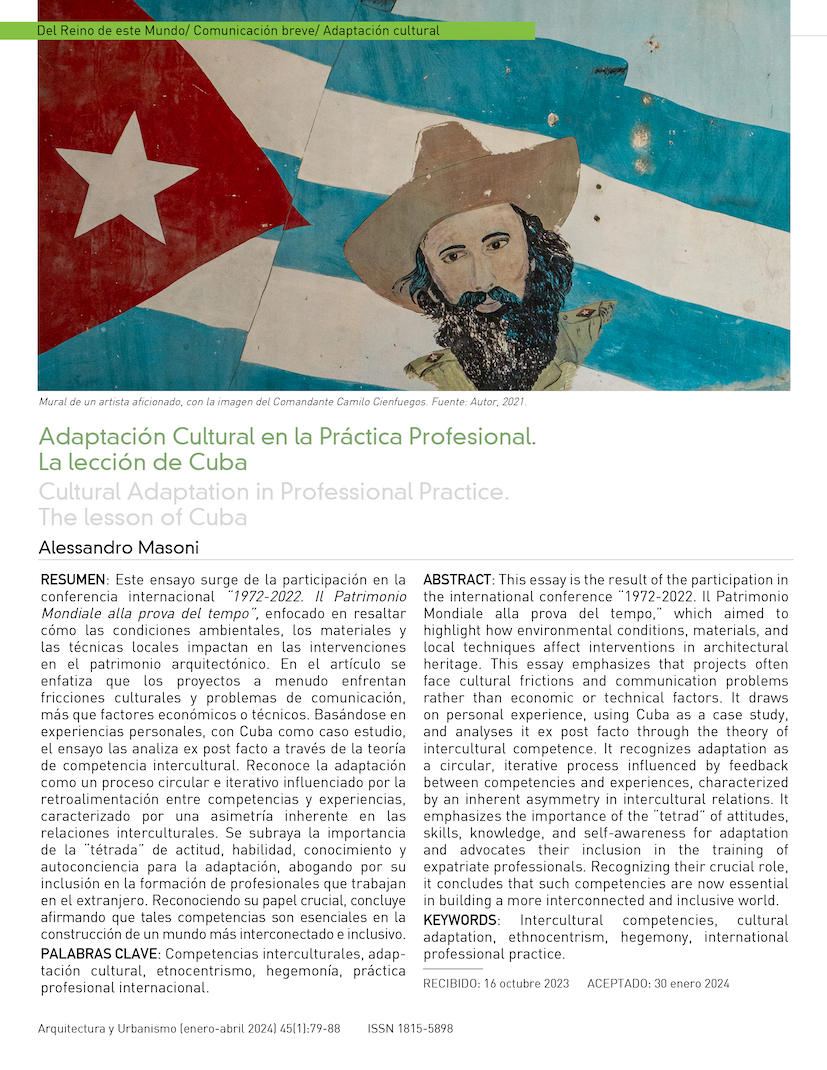Cultural Adaptation in Professional Practice. The lesson of Cuba
Keywords:
intercultural competencies, cultural adaptation, ethnocentrism, international professional practiceAbstract
This essay is the result of the participation in the international conference "1972-2022. Il Patrimonio Mondiale alla prova del tempo," which aimed to highlight how environmental conditions, materials, and local techniques affect interventions in architectural heritage. This essay emphasizes that projects often face cultural frictions and communication problems rather than economic or technical factors. It draws on personal experience, using Cuba as a case study, and analyses it ex post facto through the theory of intercultural competence. It recognizes adaptation as a circular, iterative process influenced by feedback between competencies and experiences, characterized by an inherent asymmetry in intercultural relations. It emphasizes the importance of the "tetrad" of attitudes, skills, knowledge, and self-awareness for adaptation and advocates their inclusion in the training of expatriate professionals. Recognizing their crucial role, it concludes that such competencies are now essential in building a more interconnected and inclusive world.
References
Alizadeh S, Chavan M. Cultural competence dimensions and outcomes: a systematic review of the literature. Health Soc Care Community [Internet]. 2016 [cited: 2022 Apr 8]; 24(6):[e117-e130 pp.]. Available in: https://doi.org/10.1111/hsc.12239.
Deardorff DK. Identification and assessment of intercultural competence as a student outcome of internationalization. Raleigh (North Carolina): North Carolina State University; 2004.
Cross TL, Bazron BJ, Dennis KW, Isaacs MR. Towards a culturally competent system of care. A monograph on effective services for minority children who are severely emotionally disturbed. Washington, DC: CASSP Technical Assistance Center, Georgetown University Child Development Center; 1989 [cited: 2022 Apr 15]. Available in: https://spu.edu/-/media/academics/school-of-education/Cultural-Diversity/Towars-a-Culturally-Competent-System-of-Care-Abridged.ashx.
Tervalon M, Murray-García J. Cultural Humility Versus Cultural Competence: A Critical Distinction in Defining Physician Training Outcomes in Multicultural Education. J Health Care Poor Underserved [Internet]. 1998 [cited: 2022 Apr 15]; 9(2):[117-125 pp.]. Available in: https://doi.org/10.1353/hpu.2010.0233.
Abbe A, Gulick LM, Herman JL. Cross-Cultural Competence in Army Leaders: A Conceptual and Empirical Foundation. Arlington (United States): Army Research Institute for the Behavioral and Social Sciences; 2007 [cited: 2022 Apr 15]. Available in: https://apps.dtic.mil/sti/citations/ADA476072.
Earley PC, Mosakowski E. Cultural intelligence. Harv Bus Rev [Internet]. 2004 [cited: año mes dia]; 82(10):[139-158 pp.]. Available in: https://pubmed.ncbi.nlm.nih.gov/1555982/.
Byram M. Teaching and assessing intercultural communicative competence. Clevedon (Philadelphia): Multilingual Matters; 1997.
Sweet EL. Cultural Humility: An Open Door for Planners to Locate Themselves and Decolonize Planning Theory, Education, and Practice. eJournal Public Aff [Internet]. 2018 [cited 2022 Nov 8]; 7(2):[17 p.]. Available from: https://dx.doi.org/10.21768/ejopa.v7i2.2
Cheng R, Osburn L, Alexander N, Johnson A. AIA Guide 1 * Intercultural Competence [Internet]. American Institute of Architects; 2020. [cited 2022 Nov 8]. Available from: https://www.aia.org/resource-center/guides-equitable-practice
Hall MA, Jaggar DM. Should Construction Enterprises, Working Internationally, Take Account of Cultural Differences? In: Stephenson P, editor. Proceedings 13th Annual ARCOM Conference, 1997 Sep 15-17. Cambridge (UK), Association of Reserachers in Construction Management, Vol. 1; 1997 [cited: 2022 Nov 8]. p. 1-10. Available in : http://www.arcom.ac.uk/-docs/proceedings/ar1997-001-010_Hall_and_Jaggar.pdf.
Pabittei AA, Bhinekawati R. The Impact of Cross Cultural Competence on Employee Performance Mediated by Global Mindset in Overseas Construction Projects (Lessons from a Large Construction Company in Indonesia). In: Proceedings of the 6th Annual International Conference on Management Research (AICMaR 2019). Jakarta: Atlantis Press; 2020 [cited: 2022 Nov 8]. p. 101–106. Available from: https://www.atlantis-press.com/article/125938409.
Stahl GK, Caligiuri P. The Effectiveness of Expatriate Coping Strategies: The Moderating Role of Cultural Distance, Position Level, and Time on the International Assignment. J Appl Psychol [Internet]. 2005 [cited: 2022 Nov 8]; 90(4):[603-615 pp.]. Available in: https://doi.org/10.1037/0021/9010.90.4.603
Deardorff DK, editor. The Sage handbook of intercultural competence. Thousand Oaks, Calif: Sage Publications; 2009.
Toynbee A, Kroeber AL, Kluckhohn C. Culture: A Critical Review of Concepts and Definitions. Hist Theory. 1952;4(1):127.
Partido Comunista de Cuba. Lineamientos de la política económica y social del Partido y la Revolución para el período 2016-2021. La Habana: Partido Comunista de Cuba; 2017. [Consultado: 2022 Nov 8]. Disponible en: https://siteal.iiep.unesco.org/bdnp/3332/lineaminetos-politica-economica-social-partido-revolucion-periodo-2016-2021.
Blasco M, Feldt LE, Jakobsen M. If only cultural chameleons could fly too: A critical discussion of the concept of cultural intelligence. Int J Cross Cult Manag [Internet]. 2012 [cited: 2022 Nov 8]; 12(2):[229-245 pp.]. Available in: https://doi.org/10.1177/1470595812439872
Council of Europe. White Paper on Intercultural Dialogue “Living Together as Equals in Dignity”. Strasbourg: Council of Europe Ministers of Foreign Affairs; 2008 [cited: 2022 Nov 8]. Available from: https://ec.europa.eu/migrant-integration/library-document/white-paper-intercultural-dialogue-living-together-equals-dignity_en.

Downloads
Published
How to Cite
Issue
Section
License
Copyright (c) 2024 Revista científica de Arquitectura y Urbanismo

This work is licensed under a Creative Commons Attribution-NonCommercial-NoDerivatives 4.0 International License.
a. The authors retain the copyright and guarantee the magazine the right to be the first publication of the work as well as a Creative Commons Attribution License that allows others to share the work with an acknowledgment of the authorship of the work and the initial publication in this magazine.
b. Authors may separately establish additional agreements for the non-exclusive distribution of the version of the work published in the journal (for example, place it in an institutional repository or publish it in a book), with an acknowledgment of its initial publication in this journal.
c. Authors are allowed and encouraged to disseminate their work electronically (for example, in institutional repositories or on their own website) before and during the submission process, as it can lead to productive exchanges, as well as a more early and major published papers (See The Effect of Open Access, in English).

